Finding the right POS solution for your business can be a very difficult process. Not only is technology is advancing faster than ever before, but hardware becomes smaller and more capable each year. In this age a traditional cash register’s capabilities are getting close to obsolete. Why pay thousands of dollars for a massive, clunky POS when you could pick up an iPad to ring sales on, then manage your inventory, sales reports and employee schedule at the touch of a finger? Here are a few factors to consider when choosing an iPad POS for your business.
Quick, easy sales transactions will provide your staff with excellent time management and your customers with a satisfied service experience:
Our iPad POS system allows the checkout process to be executed quickly whether you prefer to use a Bluetooth scanner to ring up your sale, or you select the product off the iPad interface. After scanning or choosing the products you’d like to sell, you can simply press the PAY button and easily accept payment in the form of cash, check, credit card or gift card. Once the payment has been accepted you have the option to print the customer’s receipt to a Bluetooth printer in-store, or send it to them via email. In the event that you need to look up a product for your customer, you can search by product name, SKU or UPC code to let your customer know whether or not that product is in stock. You can even manage a tab for someone by creating a new order for them and not closing it out. If you have your devices cross-synced on SalesVu.com, you can start ringing an order on one device and then close it out on another.
“[SalesVu’s iPad POS] has allowed us to accept credit cards at our events, which accounts for almost half of sales every week! We would not have the amount of revenue we earn without SalesVu allowing us to take credit cards in the field.” (Megan Cowan, Trinity River Vision Authority).
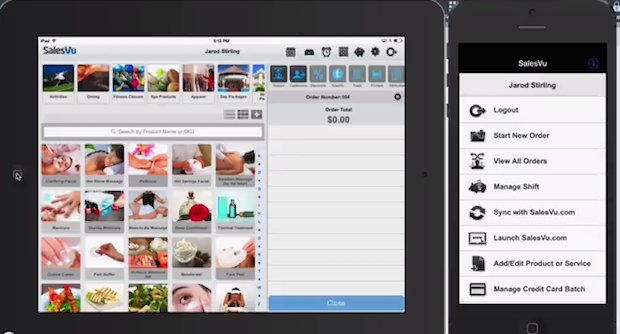
[Photo of SalesVu’s POS system for iPad and iPhone]
Manage your business at any location, any time:
With SalesVu’s iPad POS you can check the status of your store at any time by clicking the Shift Management drawer. Here you will be able to see the total sales that have been made for this day including discounts, breakdowns by payment type, how much cash is on hand and how much has been deposited to the safe. Furthermore, these figures will be imported to your cloud portal where you will easily be able to see sales reports by the time of day, employee, location, device, and product category.
“Besides being more user friendly with the cashiers, the ability to run reports and track sales from the home office has improved the efficiency of our organization tenfold.” (Allen Wallace, Lone Star Kolaches)
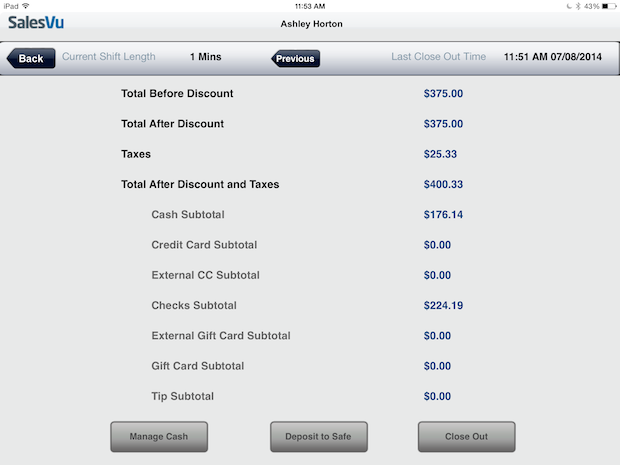 [Photo of Shift Management Screen on SalesVu’s iPad POS]
[Photo of Shift Management Screen on SalesVu’s iPad POS]
Comprehensive inventory management:
SalesVu’s inventory and supply chain management feature will automatically deduct products from your inventory every time you make a sale. It will calculate what you have in stock based on manual, POS or e-commerce transactions. Also, you can setup a low inventory threshold alert and set up the system to automatically e-mail your vendors for more inventory!
“We needed a low-cost, cloud-based solution that was simple & easy to use. We also needed a product that tracked inventory, and this is what set SalesVu apart from others we looked at.” (Phil Gilbert, Experience Life Now).
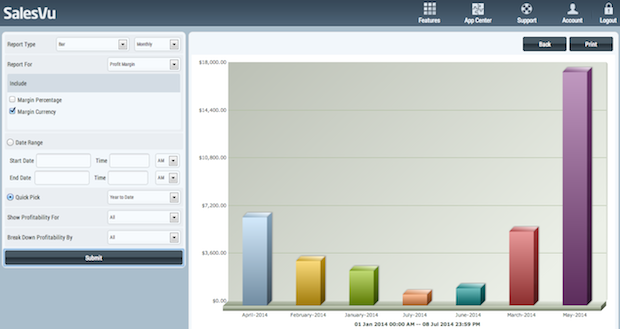
[Photo of Inventory Profitability Report, SalesVu cloud portal]
Configure employee schedules and create system-wide bulletins easily:
SalesVu offers a human capital management feature where your web portal will keep track of your staff’s performance history, shift schedule, clock in and out reports and employee access levels. Through this feature, your employees also have access to a company-wide messaging system which will allow for them to exchange documents and request to trade shifts as needed. Furthermore, labor reports can be easily generated and all data can be exported to your accounting software for payroll purposes.
“I love that there is an employee time clock on the POS – it’s nice to have everything on the same program. It makes payroll quick and easy.” (Emily Potts, Sugar House Coffee).
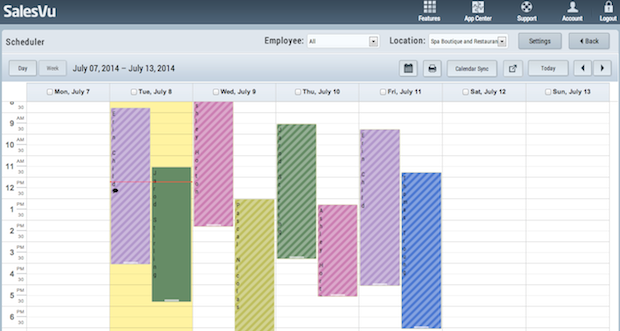 [Photo of Employee Scheduler Module, SalesVu’s cloud portal]
[Photo of Employee Scheduler Module, SalesVu’s cloud portal]
Set up your online store using our E-Commerce feature:
SalesVu’s e-commerce feature allows you to host an online store on our server with a fully customizable look and feel, as well as the URL of your choice. If you already have a company website or wish to host it on a separate server, you may do so and simply add our ecommerce widget to manage your online sales. All purchases made through your SalesVu supported e-commerce website will be added directly to your inventory and product reports. If you’d like to, you have the option to push your online orders to one of your in-store devices for review before they are processed.
[Photo of a real ecommerce website setup through SalesVu]
Automate your marketing efforts so you can spend more time focused on the business!
SalesVu can help generate more customers for your business with our viral marketing campaigns through facebook or email. Our marketing strategy allows you to send your customers coupon codes via their facebook accounts, which will automatically post to their page once they have redeemed it. With this social marketing integration, you will be able to generate detailed reports of the codes that have been redeemed which will include the discount given versus the total purchase amount. You may also use our email marketing to automatically send your customers an email when they fit certain rules that you have set – for example, once a customer completes their first tennis lesson, you can have the system automatically send them a coupon for 15% off their second lesson.

[Photo of Social Marketing manager, SalesVu cloud portal]
Seamless bookkeeping with Quickbooks Online or SalesVu’s easy accounting software:
With SalesVu, you have the option to use our easy accounting software, or you can sync with your QuickBooks online account. If you choose our easy accounting software, you have access to a detailed breakdown of expense categories, transactions made and a full profit and loss report. These reports can be broken down by date or category, and you have the option to export it to a CSV file at any time. If you already use QuickBooks, you can integrate SalesVu with your existing QuickBooks online account to import all of your data.
“It just makes so much more sense to save the man hours involved in numbers and marketing… [With SalesVu], reports are done how I want, in less time and without having to pay someone to do it for me.” (Denae Dehoyos, Cloud Cafe).
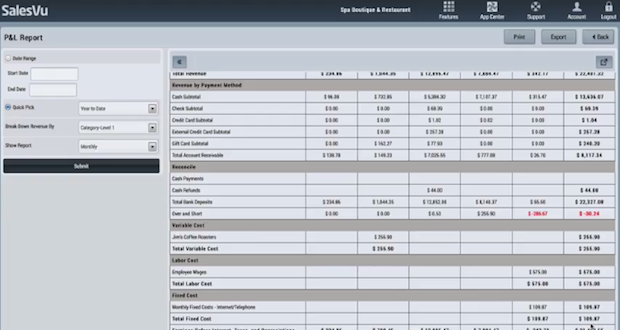
[Photo of Profit & Loss Reports brought to you by SalesVu’s easy Accounting Feature, SalesVu Web Portal]
Superior Gift Card Management:
SalesVu would be happy to provide your business with Gift Card services! In our cloud portal, you can choose whether or not you would like to accept gift cards as a payment option. From there, you will be able to view a detailed report of all gift card transactions, outstanding balances and activate or disable cards. We offer this service at a low rate of $10/month/location + 1.7% per transaction. All gift card purchases made at through your iPad POS or e-commerce website will automatically integrate with all of the back end reports you see on the cloud portal. While SalesVu does not provide the physical hardware, you may purchase fully customizable SalesVu compatible gift cards from mposgear.com or cardprinting.us.
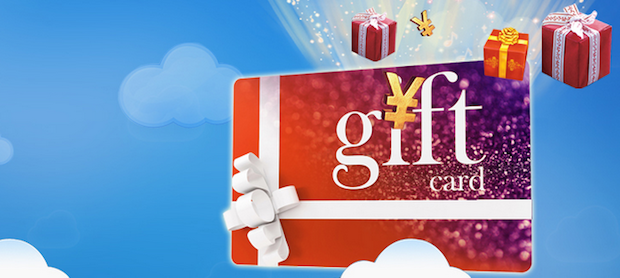
[Photo from SalesVu.com]
Competitive credit card processing rates:
SalesVu’s POS system for iPad and iPhone can provide you with reliable credit card processing from Mercury Credit Card Processing and Century Business Solutions. With the help of our trusted partners, SalesVu can process credit card transactions in-store from your POS system, online from your ecommerce website or through an emailed invoice. If you have recurring billing service set up with SalesVu, our partners will ensure that credit cards are validated prior to the billing date. Not only do you have the capability to accept Credit Card Processing with SalesVu’s partners starts as low as 2.6% – which is lower than our biggest competitors!
When he began searching for a mobile POS system, KBKR owner Kent Black started by looked into Square, who charges a fee of 2.75% of credit card sales for processing. “I noticed that SalesVu only charged 2.7% so I started looking into [that]…I was impressed by all the features SalesVu offered both on the iPad as a POS device as well as the reporting software available online.”
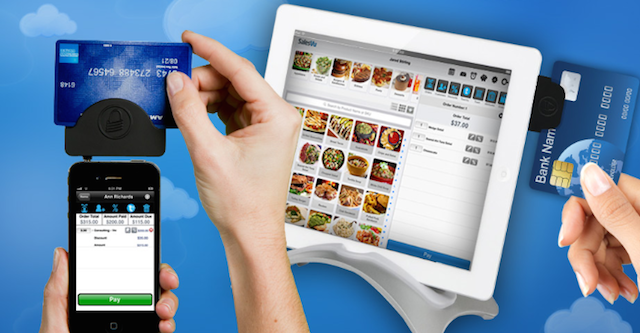
[Photo from SalesVu.com]
Manage multiple locations with ease!
SalesVu is all about mobility, even if you have multiple locations. All of our features can be managed by location and fully integrated with the cloud portal! This means you can check sales reports, employee’s stats, inventory and more on any device, wherever you are. And what’s more? You even have the option to cross-sync your devices. This means you can start an order for somebody on one iPad POS, and cash it out on a completely different device if you need to.
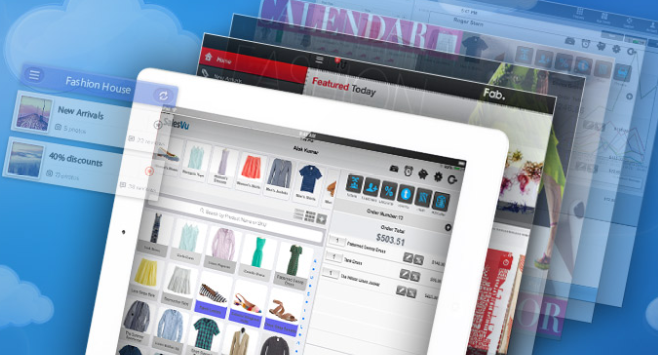
[Photo from SalesVu.com]
Allow your Customers to Reserve Tables and Schedule Appointments:
In a restaurant it is critical to be able to book reservations and manage tables. SalesVu’s table and reservation feature allows your guests to make reservations online and you can easily manage all their reservation preferences right from your POS system. With this feature, managing your physical resources is easier than ever. At any time you can re-draw your physical layout, view total sales made at each table and configure available time slots for booking. This service can be subscribed to along with other business management features in the Restaurant Bundle for $150/month/location, or by itself for $50/month/location.
SalesVu took into account that many beauty and wellness establishments need to schedule appointments. Customers can easily schedule an appointment online and can pay a non-refundable deposit at that time if they need to do so. You may also view a physical layout of your resources (massage rooms, salon chairs, etc.) and see appointments by the day, week or month. Another great aspect of this feature is that you can post a reservation widget on your existing website which will allow easy scheduling for your customers and easy management for your staff.
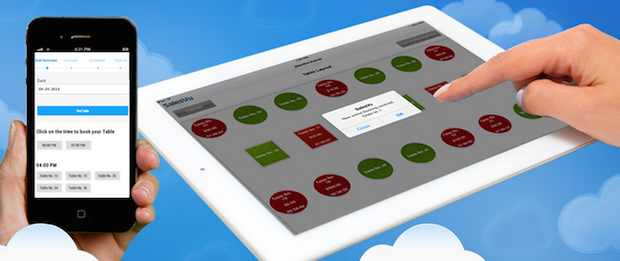 [Photo from SalesVu.com]
[Photo from SalesVu.com]
Invoicing and Billing is Easier than Ever
With our invoice management feature you can e-mail invoices directly to your customers from your iPad POS or the cloud portal. This makes it easy for customers to send electronic payments, because they receive an email with a “Pay Now” link that lets them securely pay their balance from SalesVu.com. This feature is great for many businesses in the professional service industry or anyone who needs to manage invoices easily!
The recurring billing feature will automatically charge your customers for services you have specified. After doing so, the system will send an e-mail receipt or failed payment notification to that customer. Billing information can be edited at any time, and you may also suspend billing whenever you’d like to.
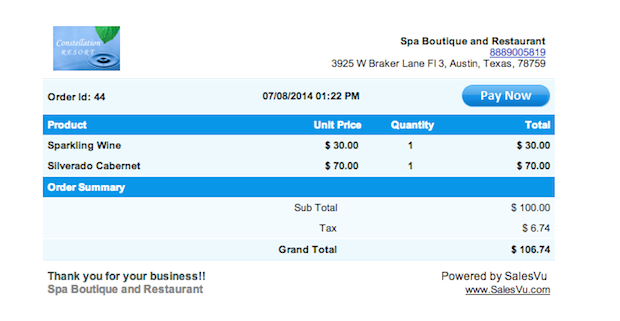
[Photo of an emailed invoice]
Software, hardware, customer service and subscription costs:
SalesVu’s business management software can be purchased in a bundle that will encompass all the features your business may need at a low rate of $150 per location, per month. If you’d like to purchase additional features, you may do so for between $10-$50 per month. While SalesVu does not provide hardware devices, it is compatible on iPad, iPhone and Android Tablets so if you or your staff already owns any of these devices, you can download the SalesVu app and get started at any time!
“As we are an all tech-savvy staff at the cafe, we enjoy having up to date technology at our fingertips – literally! It’s so much easier to just have a tablet or iPad (most of us here already own at least one) that we can pop a card reader on and handle our business,” (Denae Dehoyos, Cloud Cafe).
Also, SalesVu customer service is free for you at any time! You can call our support line at 888-900-5819 or send us an email at [email protected].
 [Photo from SalesVu.com]
[Photo from SalesVu.com]
“We chose SalesVu because of their customer service foremost. SalesVu’s associates were so helpful in answering all my questions and taking suggestions from me.” (Emily Potts, Sugar House Coffee).
Choosing the right POS system can be a challenging process so thank you for considering SalesVu. We encourage all interested parties to schedule a demonstration with our support staff on our website for more information. In this demo, a member of the SalesVu team will meet with you online, walk you through all the capabilities of the iPad POS and the cloud portal, and answer any questions for you. At the end of the demonstration, you have the option to sign up for a free 15-day trial of SalesVu’s software. What have you got to lose? Sign up for a demonstration today!




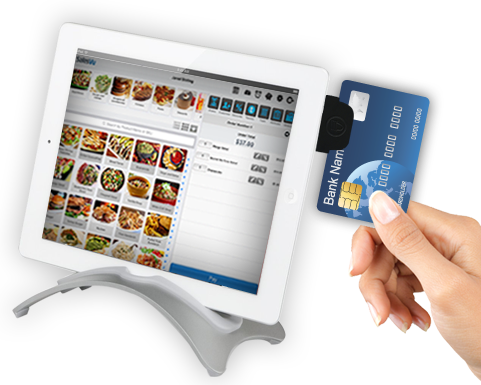







 [Photo of Shift Management Screen on SalesVu’s iPad POS]
[Photo of Shift Management Screen on SalesVu’s iPad POS] [Photo of Employee Scheduler Module, SalesVu’s cloud portal]
[Photo of Employee Scheduler Module, SalesVu’s cloud portal]




 [Photo from SalesVu.com]
[Photo from SalesVu.com]
 [Photo from SalesVu.com]
[Photo from SalesVu.com]